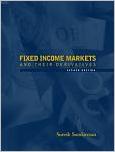| |||||
• polskie
• Zamów informacje o nowościach z wybranego tematu • kontakt |
FIXED INCOME MARKETS AND THEIR DERIVATIVESSUNDARESAN S.wydawnictwo: SW, 2002, wydanie IIcena netto: Provides an overview of fixed-income markets and their derivative markets including treasury, corporate, agency, mortgage-backed securities and debt options, futures and swap markets. Helps the students understand the theory relevant to these markets enabling them to participate in a more intelligent and confident way as corporate customers, traders, bankers, or investors. Benefits: New Chapters: Three chapters have been added, "Inflation-Indexed Debt Markets" (Chapter 7), "Emerging Debt Markets" (Chapter 11), and "Credit Risk Models and Credit Derivatives" (Chapter 18) to address these hot topics. Real Data: Real-life data is used to highlight empirical regularities, to integrate theory with practice, and to illustrate applications in pricing, risk management, hedging and related issues. Rich Content: Key content includes analysis of Treasury Markets including the auction mechanisms covering discriminatory auctions and the Treasury's experiment with uniform price auctions; description and analysis of when-issued markets, inter-dealer broker markets, auctions, and the secondary markets; corporate debt pricing and corporate financial distress; risk management techniques such as the Value-at-Risk and the Risk Adjusted Return on Capital; portfolio management techniques including dedicated portfolio (matched funding), indexation, immunization, and portfolio insurance; dealer and listed derivatives; and primary mortgage markets and the concept of securitization. Practical: This text blends academic research with practical considerations and has more institutional detail than competitors. Combined Chapters: Chapter 5, "Yield Curve & Term Structure Analysis" from the prior edition has been split into two chapters. Reorganization: Text chapters have been reorganized to maintain a smooth flow while providing the flexibility for faculty and students to focus on specific areas without losing continuity.Updated Coverage: All data and empirical evidence have been updated, and new developments in the markets have been added. Internet References: Internet Resources listed at the end of each chapter encourage learners to explore and apply chapter material to real-world events and data. Excel: Excel spreadsheets have been introduced to provide a hands-on learning experience. Detailed Descriptions: The text describes in detail the markets, the players, and the institutional features relevant to bond markets. Highlights Important Patterns: Relevant empirical regularities in each market are summarized. Presents Key Analytical Tools: The text develops analytical tools and mathematical models that are used widely by practitioners in fixed-income markets. 700 pages Księgarnia nie działa. Nie odpowiadamy na pytania i nie realizujemy zamówien. Do odwolania !. |


